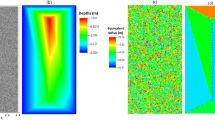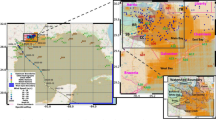Abstract
A high-resolution, summit-to-sea unstructured-grid model was used to simulate two compound flooding events in different geomorphic settings in Japan: the July 2012 flood in Kumamoto city and July 2018 flood in Okayama City, both caused by a torrential rainfall during seasonal Meiyu front but otherwise exhibiting quite different compound flood characteristics. The model shows good performance in simulating flooding extent; e.g., the Hit Rate for the inundation event in 2018 exceeds 0.9. Sensitivity tests were conducted to determine the roles/significance of levee structures along major rivers in coastal regions. Our results indicate that riverine and oceanic factors as well as levees significantly contribute to the observed flooding extents, and we are able to quantify the contributions from each factor at different locations. The model has been implemented operationally as the first nationwide 3-day compound flooding forecast system for Japan.








Similar content being viewed by others
References
Alexander LV (2016) Global observed long-term changes in temperature and precipitation extremes: a review of progress and limitations in IPCC assessments and beyond. Weather Climate Extremes 11:4–16
Bevacqua E, Maraun D, Vousdoukas MI, Voukouvalas E, Vrac M, Mentaschi L, Widmann M (2019) Higher probability of compound flooding from precipitation and storm surge in Europe under anthropogenic climate change. Sci Adv 5:eaaw531
Burek P, Van Der Knijff J, De Roo A, (2013) LISFLOOD, distributed water balance and flood simulation model: revised user manual. JRC Tech Rep 138
Davis DW (2007) In harm’s way. Civil Eng Magazine Archive 77(7):60–65
Dazzi S, Vacondio R, Mignosa P (2019) Integration of a levee breach erosion model in a GPU-accelerated 2D shallow water equations code. Water Resour Res 55:682–702. https://doi.org/10.1029/2018WR023826
Downton MW, Pielke RA (2005) How accurate are disaster loss data? The case of US flood damage. Nat Hazards 35(2):211–228
Dutta D, Alam J, Umeda K, Hayashi M, Hironaka S (2007) A two-dimensional hydrodynamic model for flood inundation simulation: a case study in the lower Mekong river basin. Hydrol Process 21:1223–1237. https://doi.org/10.1002/hyp.6682
Guyton L, Hayes A (2017) CoreLogic analysis estimates total residential insurance and uninsured flood loss for Hurricane Harvey between $25 billion and $37 billion. Business Wire. https://www.businesswire.com/news/home/20170831006476/en/
Hashimoto S, Tadono T, Onosato M, Hori M, Shiomi K (2014) A new method to derive precise land-use and land-cover maps using multi-temporal optical data. J Remote Sens Soc Jpn 34(2):102–112
Hirpa FA, Salamon P, Beck HE, Lorini V, Alfieri L, Zsoter E, Dadson SJ (2018) Calibration of the global flood awareness system (GloFAS) using daily streamflow data. J Hydrol 566:595–606
Huang W, Ye F, Zhang Y, Park K, Du J, Moghimi S, Myers E, Pe’eri S, Calzada JR, Yu HC, Nunez K, Liu Z (2021) Compounding factors for extreme flooding around Galveston Bay during Hurricane Harvey. Ocean Model 158:101735
Khanam M, Sofia G, Koukoula M, Lazin R, Nikolopoulos EI, Shen X, Anagnostou EN (2021) Impact of compound flood event on coastal critical infrastructures considering current and future climate. Na Hazards Earth Syst Sci 21:587–605. https://doi.org/10.5194/nhess-21-587-2021
Kumbier K, Carvalho RC, Vafeidis A, Woodroffe C (2018) Investigating compound flooding in an estuary using hydrodynamic modelling: a case study from the Shoalhaven River, Austrilia. Nat Hazard 18(2):463–477
Lummen N, Nakajo S, Yamada F (2014) Flooding due to torrential rainfall in Kumamoto, 2012. Int J Disas Resilien Built Environ 5(3):260–276. https://doi.org/10.1108/IJDRBE-01-2014-0013
Mishra SK, Singh VP (2013) Soil conservation service curve number (SCS-CN) methodology (Vol. 42). Springer Science & Business Media, New York
Mori N, Takemi T, Tachikawa Y, Tatano H, Shimura T, Tanaka T, Fujimi T, Osakada Y, Webb A, Nakakita E (2021) Recent nationwide climate change impact assessments of natural hazards in Japan and East Asia. Weather Climate Extremes 32:100309. https://doi.org/10.1016/j.wace.2021.100309
Muñoz Sabater J (2019) ERA5-Land hourly data from 1981 to present. Copernicus Climate Change Service C3S) Climate Data Store (CDS). https://doi.org/10.24381/cds.e2161bac
Nagata K, (2015) Quantitative precipitation estimation and quantitative precipitation forecasting by the Japan meteorological agency, Technical Reports of the Meteorological Research InstitutE No.76, https://www.mri-jma.go.jp/Publish/Technical/DATA/VOL_76/C.pdf
OECD (2016) Financial management of food risk, https://www.oecd.org/finance/financial-management-of-flood-risk.htm
Patel DP, Ramirez JA, Srivastava PK, Bray M, Han D (2017) Assessment of flood inundation mapping of Surat city by coupled 1D/2D hydrodynamic modeling: a case application of the new HEC-RAS 5. Nat Hazards 89:93–130. https://doi.org/10.1007/s11069-017-2956-6
Sanders BF, Schubert JE, Goodrich KA, Houston D, Feldman DL, Basolo V et al (2020) Collaborative modeling with fine-resolution data enhances flood awareness minimizes differences in flood perception and produces actionable flood maps. Earth’s Future 7:e2019EF001391
Santiago-Collazo FL, Bilskie MV, Hagen SC (2019) A comprehensive review of compound inundation models in low-gradient coastal watersheds. Environ Model Softw 119:166–181
Shustikova I, Neal JC, Domeneghetti A, Bates PD, Vorogushyn S, Castellarin A (2020) Levee breaching: a new extension to the LISFLOOD-FP model. Water 12:942. https://doi.org/10.3390/w12040942
Stephens TA, Savant G, Sanborn SC, Wallen CM, Roy S (2022) Monolithic multiphysics simulation of compound flooding. J Hydraul Eng 148(9):05022003
Sweet WV, Park J (2014) From the extreme to the mean: acceleration and tipping points of coastal inundation from sea level rise. Earth’s Future 2(12):579–600
Traver R (2014) Flood risk management: call for a national strategy. In: Traver R (ed) Report by the task committee on flood safety policies. American Society of Civil Engineers, Reston, Virginia
Tullos D, Byron E, Galloway G, Obeysekera J, Prakash O, Sun YH (2016) Review of challenges of and practices for sustainable management of mountain flood hazards. Nat Hazards 83(3):1763–1797
Vacondio R, Aureli F, Ferrari A, Mignosa P, Palu AD (2016) Simulation of the January 2014 flood on the Secchia River using a fast and high-resolution 2D parallel shallow-water numerical scheme. Nat Hazards 80:103–125. https://doi.org/10.1007/s11069-015-1959-4
Valle-Levinson A, Olabarrieta M, Heilman L (2020) Compound flooding in Houston-Galveston Bay during Hurricane Harvey. Sci Total Environ 747:141272. https://doi.org/10.1016/j.scitotenv.2020.141272
Wing OEJ, Bates PD, Sampson CC, Smith AM, Johnson KA, Erickson TA (2017) Validation of a 30 m resolution flood hazard model of the conterminous United States. Water Resource Res 53(9):7968–7986. https://doi.org/10.1002/2017WR020917
Yamazaki D, Togashi S, Takeshima A, Sayama T (2018) High-resolution flow direction of Japan. J Japan Soc Civil Eng (B1) 74(5):I_163-I_168
Ye F, Huang W, Zhang YJ, Moghimi S, Myers E, Pe’eri S, Yu HC (2021) A cross-scale study for compound flooding processes during Hurricane Florence. Nat Hazards Earth Syst Sci 21(6):1703–1719
Yildirim E, Ibrahim D (2019) An integrated web framework for HAZUS-MH flood loss estimation analysis. Nat Hazards 99:275–286
Zhang Y, Ye F, Stanev EV, Grashorn S (2016) Seamless cross-scale modeling with SCHISM. Ocean Model 102:64–81
Zhang YJ, Ye F, Yu H et al (2020) Simulating compound flooding events in a hurricane. Ocean Dyn 70:621–640. https://doi.org/10.1007/s10236-020-01351-x
Funding
This work was funded by One Concern Inc. Some simulations used in this paper were conducted using the following computational facilities: (1) William & Mary Research Computing for providing computational resources and/or technical support (URL: https://www.wm.edu/it/rc) (2) The Extreme Science and Engineering Discovery Environment (XSEDE), which is supported by National Science Foundation grant number OCI-1053575; (3) Texas Advanced Computing Center (TACC), The University of Texas at Austin (for providing HPC resources that have contributed to the research results reported within this paper.
Author information
Authors and Affiliations
Contributions
All authors contributed to this study’s conception and design. Model simulation were designed by Y. Joseph Zhang, Wei Huang, and Zhuo Liu. Material preparation, data collection were performed by the Once Concern Inc team including Zhuo Liu, Yi Liu, Sam Lamont, Yu Zhang, Feyera Hirpa, Ting Li, Brett Baker, Wang Zhan, and Shabaz Patel. Data used for SCHISM modeling were prepared by Y. Joseph Zhang, Wei Huang, and Hao-Cheng Yu. Text has been revised and modified by Y. Joseph Zhang, Zhuo Liu, and Nobuhito Mori. All authors read and approved the final manuscript.
Corresponding author
Ethics declarations
Conflict of interests
The authors declare they have no financial interests.
Ethical approval
I, Wei Huang, hereby, consciously assure that for the manuscript, Simulation of compound flooding in Japan using a nationwide model, the following is fulfilled: This manuscript is not submitted to more than one journal for simultaneous consideration, the submitted work is original and has not been published elsewhere in any form or language (partially or in full), the study is not split up into several parts to increase the quantity of submissions and is not submitted to various journals or the one journal over time, results are presented clearly, honestly, and without fabrication, falsification or inappropriate data manipulation, all authors adhere to discipline-specific rules for acquiring, selecting and processing data, and no data, text, or theories by others are presented as if they were the authors’ own. Proper acknowledgements to other works are given, summarized and paraphrased, quotation marks are used for verbatim copying of material, and permissions are secured for material that is copyrighted.
Additional information
Publisher's Note
Springer Nature remains neutral with regard to jurisdictional claims in published maps and institutional affiliations.
Appendix: tidal validation
Appendix: tidal validation
The coastal SCHISM model was validated at 33 major JMA tidal gauges in 2017 (Fig. 9). Time series of water level at these 33 stations are shown in Fig. 10.
The average correlation is 0.97,veraged R2 value is 0.95, and average mean absolute error (MAE) is 7.4 cm, which is much smaller than the typical tidal range of ~ 1–4 m in Japan (Fig. 10). The observational data used for model validation is the tide data obtained from Japan Oceanographic Data Center (JODC, https://jdoss1.jodc.go.jp/vpage/tide.html). Comparisons at the nearest stations of Kumamoto city (Fig.
11a) and Okayama city (Fig. 11b) are shown in Fig. 11c and d, respectively. MAE and RMSE are listed in Table 2.
Rights and permissions
Springer Nature or its licensor (e.g. a society or other partner) holds exclusive rights to this article under a publishing agreement with the author(s) or other rightsholder(s); author self-archiving of the accepted manuscript version of this article is solely governed by the terms of such publishing agreement and applicable law.
About this article
Cite this article
Huang, W., Zhang, Y.J., Liu, Z. et al. Simulation of compound flooding in Japan using a nationwide model. Nat Hazards 117, 2693–2713 (2023). https://doi.org/10.1007/s11069-023-05962-7
Received:
Accepted:
Published:
Issue Date:
DOI: https://doi.org/10.1007/s11069-023-05962-7







